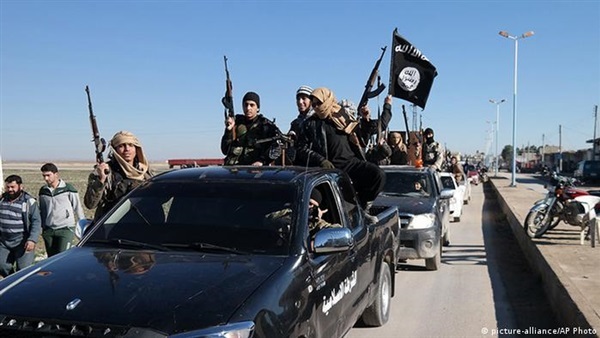ISIS Syria's policy of financing, smuggling elements from Al-Hawl

In an attempt to re-grow its
networks in order to implement more brutal terrorist operations than before to
affirm its presence inside Syrian territory, ISIS and its terrorist cells began
practicing financial extortion by intimidating to raise funds to finance its
operations and re-establish its networks, threatening to resort to violence to
implement its plan on a larger scale, especially in the governorates of Raqqa
and Deir ez-Zor.
This is in addition of using
trenches and tunnels dug with primitive tools to smuggle its members from
Al-Hawl camp and to carry out mass killings inside the camp.
Despite the defeat of the terrorist
organization ISIS in Syria two years ago, the organization continues to
terrorize people, especially in the northeast region, using financial extortion
against business owners to finance its operations and re-grow its networks.
U.S. military ground operations in
northwestern Syria have targeted top ISIS leaders, most notably Abu Bakr
al-Baghdadi, who killed himself during an October 2019 raid near the border
with Turkey that was carried out by the elite Delta Force.
His successor, Abu Ibrahim
al-Hashimi al-Qurayshi, detonated himself with an explosion during a similar
raid in February this year.
ISIS was defeated in Syria in 2019
and since then, its leaders have gone into hiding to prevent being targeted by
U.S. forces.
However, ISIS fighters maintain a
low-level insurgency in Iraq and Syria, and the group continues to inspire
followers in the West to commit violent attacks.
The terrorist organization’s cells
used various methods to communicate their demands after determining the
targets, as the victims say that the group relies mainly on messaging
applications, especially “WhatsApp”, which uses end-to-end encryption and
provides the option of anonymity of those who work with ISIS, but It also
delivers written notices stamped with the group's logo to the homes of its
targets, an arguably more effective intimidation tactic.
Ransom requests usually include the
name of the target, the amount requested in US dollars, and where the payment
should be delivered, in addition to messages containing clear and explicit
warnings to deliver the money quickly and discreetly to avoid punishment.
Failure to comply with those demands
has led to ISIS attacks on businesses, kidnappings and targeted killings, and
ISIS reportedly destroyed several oil wells in January when officials refused
to pay.
For months, ISIS has been using the
threat of violence to operate extensive protection rackets in Raqqa and Deir
Ezzor governorates. The inability of local authorities to provide sufficient
protection from ISIS has left many people with no choice but to pay.
ISIS relies on its extensive
knowledge of local communities to set targets and determine the size of the tribute,
usually targeting professionals such as doctors and pharmacists, and business
owners including prominent farmers, herders, shopkeepers, traders and
investors.
The scale and frequency of these
forced payments varies. Some of the group’s victims said they pay between $700
and $1,500 annually, while investors overseeing oil fields in eastern Deir
Ezzor reportedly pay more than $5,000 per well per month.
Estimating ISIS’s earnings from
these extortions is difficult, but media reports suggest the group is generating
several million dollars a year this way. While far less than the $80 million a
month the group was generating in 2015, it is more than enough to make the
group dangerous. ISIS’s territorial defeat in 2019 reduced its state-like
financial responsibilities, and its current cash flow is more than sufficient
to finance its hit-and-run operations and ensure its survival.
Moreover, the Autonomous
Administration of North and East Syria (Rojava) has found a network of trenches
and tunnels under al-Hawl camp, east of al-Hasakah.
The security sources said these
trenches and tunnels were used by sleeper cells loyal to the ISIS terrorist
organization to smuggle persons and carry out murders and assassination
attempts.
A video recording inside the camp
showed how tunnels were dug with primitive tools, covered with metal and wooden
panels for camouflage, amid a group of tents inhabited by displaced Syrians and
Iraqi refugees.
Escaping Incidents are on the rise
in the camp, which houses about 56,000, most of whom are displaced Syrians and
Iraqi refugees.
The security source and director of
al-Hol camp, Hamrin Hassan, said that sleeper cells inside and outside the
center are linked to human smuggling networks loyal to ISIS.
Hassan explained that they
communicate with the terrorist organization through social media platforms, and
the first destination after the escape is the Idlib governorate or other areas
in northern Syria under Turkish influence.
After that, the same networks
transport the escapees from al-Hol into Turkish territory and from there to
their homelands, often done in exchange for large sums of money.
Hassan believes that the al-Hol camp
is an international issue, asserting that concerned countries must take quick,
drastic decisions and measures to provide appropriate solutions.
The official warned against not
solving this issue, indicating that these families' presence on the border
might spread and increase ISIS danger inside and outside the camp





